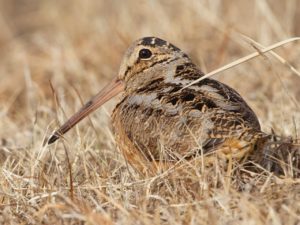
On a warm day in late March a few years back, while conducting prescribed fires on one of our piedmont Wildlife Management Areas, our crew had the good fortune to observe a woodcock doing what I thought was part of their courtship display. Tootling along on one of our disked fire lines, we thought he may have been addled by love, throwing caution to the wind and risking life and wing for a mate, but it turns out what we observed was part of their feeding ritual. Check out the Cornell Ornithology Lab website for much more on this and all aspects of woodcock ecology American Woodcock Sounds, All About Birds, Cornell Lab of Ornithology. And to see this feeding dance: Photos and Videos for American Woodcock, All About Birds, Cornell Lab of Ornithology .
This strutting ritual along the ground as they feed is hilarious from a human standpoint. I cannot describe it in words other than to say it looks like a cross between a strut and a crazy dance move. On this day our burn boss happened to be quite a character himself, and he took to imitating the woodcock, which seemed unafraid of us. I won’t mention his name, but as we drove along behind him and the woodcock, Mr. Burn Boss, complete with cigar stub in his mouth, strutted along behind the woodcock in an almost exact imitation of the dance he was doing. This went on for a minute or more until we were all teary eyed and hoarse from laughing and the woodcock got tired of the game and left. This story lives on in infamy, just one of many derived from decades of field work where humor often gets you through long days of intense labor. I am sure it will be told at Mr. Burn Bosses retirement…maybe we can even get him to do it for us again.
But back to the woodcock, or timberdoodle as many hunters like to call them; they are an oddball in many ways. In addition to their long bill used to probe for earthworms, the tip of which they can open and close without opening the entire bill, they have huge eyes. Their brain is turned upside down and sideways in their cranium to allow for such big orbs. Further they have small legs and feet compared to their body size, but don’t let that fool you, they can and will run at times. Their flight methods are also interesting. I have heard their flight described as looking like a feathered bat. Their wings are long compared to their body which makes their flight appear awkward in cover, but when they fly in the open, they are fast and powerful – capable of migrating long distances…which they do every year. Leaving places in the northern U.S. and Canada and crossing all of North America, making stopovers along the way, many eventually end up in Louisiana, Mississippi, Alabama or other southern realms. But some overwinter right here in Virginia, and they nest and hatch clutches here, too. To add to this strangeness, they always have a clutch of four mottled eggs which hatch synchronously. But more amazing is that their young grow exceedingly fast, being hard to distinguish from adults after only 28 days. Some woodcock remain in Virginia all summer, but many fly north, young of the year and adult birds, too. Much remains mysterious about woodcock, though, because their migration patterns have made it hard to study them. Recent improvements in GPS transmitters are helping to fill knowledge gaps. The new GPS transmitters are now small enough to allow placement on woodcock. Check out this woodcock tracker site for more information: Home (woodcockmigration.org) . Our own DWR is proud to be a part of this American Woodcock study.
In terms of their being an upland gamebird, they are magnificent in my opinion. Every upland bird hunter has a favorite for their own reasons…and mine has become the woodcock. Their understated beauty, willingness to hold tight for a young dog’s point and acrobatics in flight make them a real treat to hunt. Though they are in decline across their range, they can be found in local abundance here in Virginia if the weather does not turn icy for prolonged periods. If you fear hunting is causing their decline, note that there are not that many upland bird hunters, and many are like me; my typical season is long on finds and points and very short on kills. For example, one season I had eighty finds or points and only three kills. You would be surprised how many hunters of small game cherish being out with their dogs much more than harvesting game.
And about those famous woodcock “sky dances”, right now is a great time to see them. I drink my coffee every morning on my front porch in rural Prince Edward County, rain, snow, cold or warm. If you get out about 6:30, and settle in, their peenting, calling, and flying will begin soon afterwards. Sit near swampy bottoms along fields, or near cutovers less than six- or eight-years post cut and look towards the eastern horizon. Silhouetting them is the best way to spy them. While they are known for their displays in the evenings, mornings are also an excellent time to see and hear them. Listen, too, for the songbirds calling to start about fifteen minutes after the first woodcock begin their day…as they say, “the early bird gets the worm” and in the case of the woodcock, it is true.




